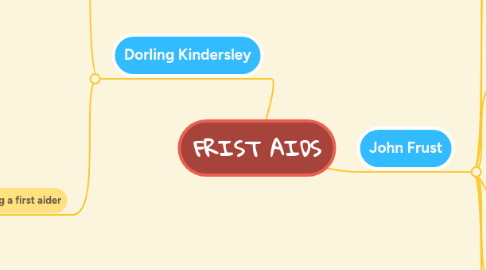
1. John Frust
1.1. First Aid
1.1.1. Preserve the life of the victim
1.1.2. Prevent worsening of the situation
1.1.3. Promote recovery from the injury or illness
1.2. Your Role in a First Aid Situation
1.2.1. Ensure your safety and the of bystanders
1.2.2. eManage an incident properly and control the situation
1.2.3. Call for appropriate emergency services
1.2.4. Delegate tasks to bystanders as required
1.2.5. Provide appropriate first aid to victims
1.2.6. Document your findings and actions
1.2.7. Provide an accurate handover to EMS
1.3. Managing an Incident
1.3.1. Motor Vehicle collision Incident
1.3.2. Water
1.3.3. Fire and smoke
1.4. calling Emergency Services
1.4.1. location of the incident
1.4.2. type of situation
1.4.3. telephone number you are calling from
1.4.4. Specific detail about the victims
1.5. Protecting Yourself from Infection
1.5.1. Protect Yourself with Infection Control Gear
1.6. Measuring Vital Signs
1.6.1. pulse Rate
1.6.2. Respiratory Rate
1.6.3. Body Temparature
1.6.4. Blood Pressure
1.6.5. Watch the Trend
1.7. Gathering Important Information from a Victim: AMPLE History
1.7.1. AMPL Questions for a Conscious Victim
1.7.1.1. Allergies
1.7.1.2. Medications
1.7.1.3. Past medical history
1.7.1.4. Last oral intake
1.7.1.5. Events leading up to the incident
2. Dorling Kindersley
2.1. First Aids
2.1.1. Aim and Objective
2.1.1.1. To understand your own abilities and limitations
2.1.1.2. To say safe and clam at all times
2.1.1.3. To assess a situation quickly and calmly and summon help if necessary
2.1.1.4. To assist the casualty and provide the necessary treatment, with help of others if possible
2.1.1.5. To pass on relevant information to the emergency services, or the person who takes responsibility for the casuaity
2.1.1.6. To be aware of your own needs
2.2. Becoming a first aider
2.2.1. What is a First Aider
2.2.1.1. How to prepare yourself
2.2.1.1.1. Be calm in your approch
2.2.1.1.2. Be aware of risks
2.2.1.1.3. Build and maintain trust
2.2.1.1.4. Give early treatment
2.2.1.1.5. call appropriate help
2.2.1.1.6. Remember your own needs
2.2.2. Protection from infection
2.2.2.1. Thorough hand washing
2.2.2.1.1. Use soap and water if available, or rub your hands with alcohol gel.
2.2.2.2. Using protective gloves
2.2.2.2.1. using protective gloves
2.2.2.2.2. dealing with waste
2.2.2.3. Dealing with a casualty
2.2.2.3.1. Building trust
2.2.2.3.2. Diversity and communication
2.2.2.3.3. listen carefully
2.2.2.3.4. When a casualty resists help
2.2.2.3.5. treating the casualty
2.2.2.3.6. English help from others
2.2.2.3.7. care of personal belongings
2.2.2.3.8. keeping notes
2.2.3. Requesting help
2.2.3.1. telephoning for help
2.2.3.2. making the call
2.2.4. The use of medication
2.2.4.1. remember your own needs
2.2.4.1.1. immediately after an incident
2.2.4.1.2. later reactions
